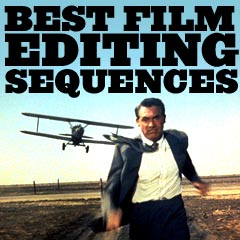
|
Sequences of All-Time: From the Silents to the Present 1960-1966 |
| Film Title/ Director & Editor and Film Description | |||||||||||
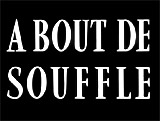
|
Breathless (1960, Fr.) (aka A Bout de Souffle) d. Jean-Luc Godard The French "New Wave" (La Nouvelle Vague) movement by film critics-turned directors challenged traditional 'rules' of film editing, repudiating most of the conventions of the time. This innovative and fresh landmark film (and others) liberally used the jump cut (in non-logical ways), the hand-held camera, natural lighting, non-linear storytelling, on-location shootings, and loose, improvised direction and editing. The rough-hewn film was particularly notable for the use of breakthrough jump cuts in the aimless "Why are you unhappy?" discussion between young thug and car thief Michel Poiccard/Laszlo Kovacs (Jean-Paul Belmondo) and flighty, short-haired, tight T-shirt wearing American girlfriend Patricia Franchini (Jean Seberg) while he was driving a stolen convertible through Paris. During the scene, the camera focused from behind on her for nearly the entire sequence. He responded: "I can't live without you...I love a girl with a lovely neck, lovely breasts and a lovely voice, lovely wrists, a lovely brow, and lovely knees..." In the first five-minute driving sequence that introduced the male character as a Bogart-infatuated male, the camera jerked around without any traditional sense of continuity or establishing shots, etc. In the film's central 23-minute sequence that was a hallmark of spontaneous and improvisational acting/film-making, Patricia discussed romance, beauty, and novelist William Faulkner and considered where she should hang her Renoir poster, while Michel repeatedly tried to convince her to have sex with him ("I want to sleep with you again because you're beautiful...I'd like to sleep with you again"), and finally succeeded (off-screen). |
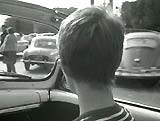 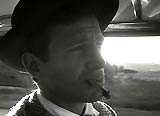 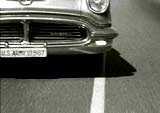 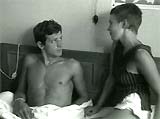
|
|||||||||

|
d. Alfred Hitchcock In Hitchcock's classic, brutal shower murder scene, an unexplainable, unpremeditated, and irrational murder, the major star of the film - Marion Crane (Janet Leigh) - was shockingly stabbed to death after the first 47 minutes of the film's start. It was the most famous murder scene ever filmed and one of the most jarring. The scene took a full week to complete, using fast-cut editing of 78 pieces of film, 70 camera setups, and a naked stand-in model (Marli Renfro) in a 45-second impressionistic montage sequence, involving the inter-cutting of slow-motion and regular speed footage. The audience's imagination filled in the illusion of complete nudity and fourteen violent stabbings. Actually, the shower victim never really appeared nude (although the audience was teased) and there was only implied violence - at no time did the knife ever penetrate deeply into her body. In only one split instant, the knife tip touched her waist just below her belly button. Chocolate syrup was used as 'movie blood', and a casaba melon was chosen for the sound of the flesh-slashing knife. The horrific scene commenced when a figure with dark face, faint white eyes, and tight hair bun entered the bathroom and whipped aside the shower curtain. The killer wielded a menacing, phallic-like butcher knife high in the air - at first, it appeared to be stab, stab, stabbing us - the victimized viewer! The piercing, shrieking, and screaming of the violin strings of Bernard Herrmann's shrill music played a large part in creating sheer terror during the horrific scene - they started 'screaming' before Marion's own shrieks. Marion turned, screamed (her wide-open, contorted mouth in gigantic close-up), and vainly resisted as she shielded her breasts, while the large knife repeatedly rose and fell in a machine-like fashion. The murderer appeared to stab and penetrate into her naked stomach, shattering her sense of security and salvation. The savage killing was kinetically viewed from many angles and views. The only blood was seen washing down and circling into the shower drain - paired to a dissolving, rotating, zoom-out closeup of Marion's unblinking eye.
|
  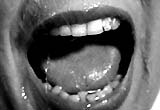 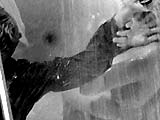 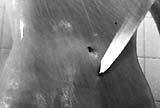 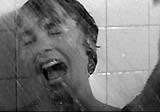
|
|||||||||
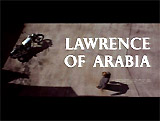
|
d. David Lean
David Lean's sweeping, timeless desert epic about eccentric British officer T.E. Lawrence (Peter O'Toole) was pervaded with a romantic, golden-hued glow, especially notable in one of the earlier scenes. 29 year-old Lawrence had taken a desk job in the British headquarters in Cairo in 1917 - but he was disgruntled and uninterested in his work as a cartographer coloring maps, and wanted to get involved in adventures out in the desert. The dedicated, knowledgeable, but undisciplined Lawrence was assigned to special duty with a transfer to Arabia ("For ordinary men, it's a burning, fiery furnace"). He contemplated his future: "It's going to be fun," as he lit the cigar of the Arab Bureau's Mr. Dryden (Claude Rains). He held up the burning match to gaze at it as it slowly burnt down. It was an exultant jump-cut image - as he blew out the burning hot match, rather than snuffing it out with his fingers as usual ("The trick...is not minding that it hurts"), the screen became overwhelmed by the magnificent glow of the blazing, reddish-orange Arabian sun, first seen as a growing sliver of bright light. Then, it slowly rose over and dissolved into the endless horizon of the golden sand-duned desert - the site of his new mission. |
  
|
|||||||||

|
d. David Lean
A second marvelous sequence was the attack on the train, prefaced by Prince Feisal's (Alec Guinness) words: "Lawrence is your man." The camera cut immediately to "hero" T.E. Lawrence (Peter O'Toole), positioned on a sand dune ridge in one of the film's most memorable sequences. He pushed a plunger to detonate dynamite laid on the tracks of an approaching Turkish train. The band of Arab guerrillas opened fire with British machine guns on the derailed and sabotaged train from the top of the sand-dune, while the ambush was photographed by syndicated American journalist from the Chicago Courier, Jackson Bentley (Arthur Kennedy).
Lawrence called for his men to stop, then rose in his flowing white robes and ran in front of the line of fire, shooting flares to get his men's attention. With one sweeping hand, he led the bloody desert assault down the sand dune hillside: " Come on, men!", as they looted the train for treasures. He climbed aboard the roof of the train in his sandals and long-flowing robe, parading triumphantly like a god before rows of cheering Arabs enthusiastically chanting: "Aurens, Aurens." In a long tracking shot, the charismatic, egotistical figure cast a giant shadow on the ground that his men followed. He was framed against the bright sun - his arms outstretched. |
||||||||||
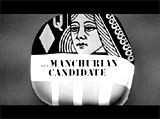
|
The Manchurian Candidate (1962) d. John Frankenheimer
In the famous brainwashing/dream sequence in this political thriller, Captain Bennett Marco (Frank Sinatra) and his platoon were present and onstage at a ladies' auxiliary meeting. The images switched between the imagined, delusionary, conditioned point of view within the brainwashed soldiers' heads and actual reality. They had been conditioned, programmed, and manipulated by a Pavlovian Chinese brainwasher to imagine attendance at a ladies' auxiliary meeting/tea party. The bravura, tour de force scene shifted seamlessly from the Communist scene to the garden party. To surrealistically convey this depth of meaning, the camera began a slow, 360 degree, all-encompassing tracking shot around the meeting in the lecture hall - exhibiting a ladies' garden club party in the Spring Lake Hotel in New Jersey where an elderly white woman, Mrs. Henry Whittaker spoke tediously on the topic of "Fun With Hydrangeas." The laconic platoon was seated on stage with her - in the audience were about two dozen elderly ladies taking in the lecture on horticulture. When the camera returned to the stage, 360 degrees later after the cyclical camera movement, a tall, bald Communist Chinese/Korean doctor-spylord Yen Lo (Khigh Dhiegh) was actually in charge and had taken the woman's place and voice. He introduced the captured, passive and impotent men, all drugged and hypnotized, who were seated in front of giant poster/photographs of Joseph Stalin and Mao Tse Tung. The doctor addressed an interested, assembled coalition of uniformed Koreans, Chinese, Soviets and civilians in a public demonstration of the powers of hypnotism. |
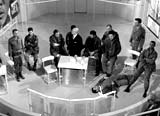  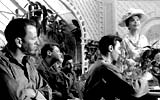 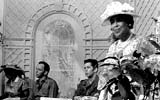
|
|||||||||
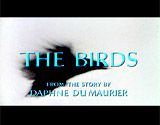
|
d. Alfred Hitchcock Hitchcock's first film with Universal Studios was this modern thriller/masterpiece, an apocalyptic story of a northern California coastal town filled with an onslaught of seemingly unexplained, arbitrary and chaotic attacks of ordinary birds - not birds of prey. One of the most remarkable, well-edited sequences was the one of the attack of seagulls swooping down on a gas station attendant at the Capitol Oil Company. When knocked to the ground, the gasoline hose began to send a stream of gasoline downhill. Everyone watched from a nearby restaurant as a traveling salesman drove up, lit a cigar, and not comprehending warnings, set off an explosion and was engulfed by flames. The service station also exploded in an inferno. From a bird's point of view, a shot high above Bodega Bay, a single seagull (joined shortly by others) floated into the foreground, looking down on the fire below that spread through the entire town square. They noisily screeched in triumph and gathered together for an attack. Everyone evacuated from the restaurant, rushing into a frantic scene of flames and flapping, screeching birds. Melanie (Tippi Hedren) sought shelter in a telephone booth where she became trapped and powerless in a mechanism of communication - like a bird in a cage. A brilliant overhead shot captured Melanie's terror-stricken position as she beat her arms around (bird-like) in the enclosure, with birds assaulting her from every direction. A man blinded by the birds (that attacked him as he drove his car) plowed into parked cars and it burst into flames.
Firefighters arrived bringing firehoses - one out-of-control hose spewed water toward the booth enclosing Melanie and obscured her vision. Two horses pulling a wagon without a driver galloped and careened through the street. One individual with a bloodied face and birds attacking his face leaned against the outside of the booth where Melanie was entrapped. Two seagulls aimed for her - they smashed into and broke the glass on two sides of the booth. Mitch (Rod Taylor) saved Melanie and protectively led her into the now-empty restaurant. |
 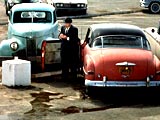 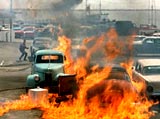 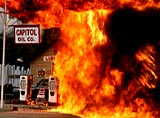 
|
|||||||||
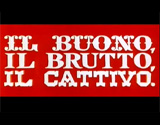 
|
The Good, the Bad and the Ugly (1966, It.) (aka Il Buono, Il Brutto, Il Cattivo) d. Sergio Leone In the final installment of Sergio Leone's violent, spaghetti western trilogy, there was a climactic, excessive scene of a showdown between the three ruthless, gunfighting drifters:
All three of the main characters, basically amoral, anti-social bounty hunters, outlaws, and murderers, were forced to form an uneasy partnership or alliance in the film's climactic graveyard shootout. The opportunistic desperados found themselves confronting and facing off one last time for the fortune in a three-way duel/showdown (a quintessential Mexican standoff) in the vast circular Sad Hill Cemetery, enhanced by Ennio Morricone's score ("The Trio").
There were repeated detailed closeups (of guns in holsters and facial expressions with an astonishing 96 edits or cuts) that occurred with increasing speed and frequency, until guns were drawn. The gunfight culminated in Blondie's gunning down of Angel Eyes who collapsed dead into an open grave. [Note: Blondie knew that Tuco's gun was empty, therefore giving him the advantage of knowing to shoot at Angel Eyes.] The scene was mimicked or spoofed in Alexander Payne's Election (1999). |
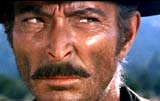 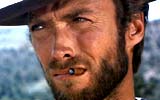 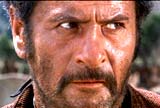
|
|||||||||